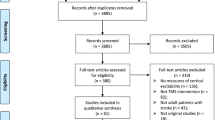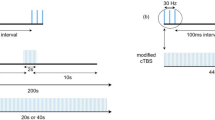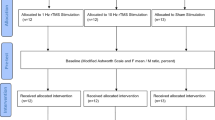Abstract
Repetitive transcranial magnetic stimulation (rTMS) and intermittent theta-burst stimulation (iTBS) can be used to manage post-stroke spasticity, but a meta-analysis of the recent randomized-controlled trials (RCTs) is lacking. Our aim is to perform a meta-analysis of the RCTs that investigated the efficacy of rTMS in patients with post-stroke spasticity. PubMed, Embase, and Cochrane Library databases were searched for eligible papers published up to February 2020. The primary outcome was the Modified Ashworth Scale (MAS), measured as the effect of rTMS compared with controls and after rTMS (using a change score calculated separately in the active and sham treatment groups). Finally, five papers and eight data sets were included. rTMS had no significant benefit on MAS in patients with post-stroke spasticity compared to sham treatment (WMD = − 0.29, 95% CI − 0.58, 0.00; P = 0.051). When analyzing the change score in the treatment groups, a significant effect of rTMS was observed (WMD = − 0.27, 95% CI − 0.51, − 0.04; P = 0.024). When analyzing the change score in the sham treatment groups, no significant effect of sham treatment was observed, indicating no placebo effect (WMD = 0.32, 95% CI: − 0.40, 1.04; P = 0.387). We included the sample size, year of publication, percentage of male patients, and age difference in each study as covariates, and performed a meta-regression. The results showed no association between these variables and the MAS. Compared with sham stimulation, rTMS did not show a significant reduction in MAS for the patients who experienced post-stroke spasticity, but the patients reported a better outcome in MAS on a before-after scenario.




Similar content being viewed by others
Data availability
The datasets used and/or analyzed during the current study are available from the corresponding author on reasonable request.
References
Sacco RL, Kasner SE, Broderick JP, Caplan LR, Connors JJ, Culebras A, Elkind MS, George MG, Hamdan AD, Higashida RT, Hoh BL, Janis LS, Kase CS, Kleindorfer DO, Lee JM, Moseley ME, Peterson ED, Turan TN, Valderrama AL, Vinters HV, American Heart Association Stroke Council CoCS, Anesthesia, Council on Cardiovascular R, Intervention, Council on C, Stroke N, Council on E, Prevention, Council on Peripheral Vascular D, Council on Nutrition PA, Metabolism (2013) An updated definition of stroke for the 21st century: a statement for healthcare professionals from the American Heart Association/American Stroke Association. Stroke 44:2064–2089
Collaborators GBDLRoS, Feigin VL, Nguyen G, Cercy K, Johnson CO, Alam T, Parmar PG, Abajobir AA, Abate KH, Abd-Allah F, Abejie AN, Abyu GY, Ademi Z, Agarwal G, Ahmed MB, Akinyemi RO, Al-Raddadi R, Aminde LN, Amlie-Lefond C, Ansari H, Asayesh H, Asgedom SW, Atey TM, Ayele HT, Banach M, Banerjee A, Barac A, Barker-Collo SL, Barnighausen T, Barregard L, Basu S, Bedi N, Behzadifar M, Bejot Y, Bennett DA, Bensenor IM, Berhe DF, Boneya DJ, Brainin M, Campos-Nonato IR, Caso V, Castaneda-Orjuela CA, Rivas JC, Catala-Lopez F, Christensen H, Criqui MH, Damasceno A, Dandona L, Dandona R, Davletov K, de Courten B, deVeber G, Dokova K, Edessa D, Endres M, Faraon EJA, Farvid MS, Fischer F, Foreman K, Forouzanfar MH, Gall SL, Gebrehiwot TT, Geleijnse JM, Gillum RF, Giroud M, Goulart AC, Gupta R, Gupta R, Hachinski V, Hamadeh RR, Hankey GJ, Hareri HA, Havmoeller R, Hay SI, Hegazy MI, Hibstu DT, James SL, Jeemon P, John D, Jonas JB, Jozwiak J, Kalani R, Kandel A, Kasaeian A, Kengne AP, Khader YS, Khan AR, Khang YH, Khubchandani J, Kim D, Kim YJ, Kivimaki M, Kokubo Y, Kolte D, Kopec JA, Kosen S, Kravchenko M, Krishnamurthi R, Kumar GA, Lafranconi A, Lavados PM, Legesse Y, Li Y, Liang X, Lo WD, Lorkowski S, Lotufo PA, Loy CT, Mackay MT, Abd El Razek HM, Mahdavi M, Majeed A, Malekzadeh R, Malta DC, Mamun AA, Mantovani LG, Martins SCO, Mate KK, Mazidi M, Mehata S, Meier T, Melaku YA, Mendoza W, Mensah GA, Meretoja A, Mezgebe HB, Miazgowski T, Miller TR, Ibrahim NM, Mohammed S, Mokdad AH, Moosazadeh M, Moran AE, Musa KI, Negoi RI, Nguyen M, Nguyen QL, Nguyen TH, Tran TT, Nguyen TT, Anggraini Ningrum DN, Norrving B, Noubiap JJ, O'Donnell MJ, Olagunju AT, Onuma OK, Owolabi MO, Parsaeian M, Patton GC, Piradov M, Pletcher MA, Pourmalek F, Prakash V, Qorbani M, Rahman M, Rahman MA, Rai RK, Ranta A, Rawaf D, Rawaf S, Renzaho AM, Robinson SR, Sahathevan R, Sahebkar A, Salomon JA, Santalucia P, Santos IS, Sartorius B, Schutte AE, Sepanlou SG, Shafieesabet A, Shaikh MA, Shamsizadeh M, Sheth KN, Sisay M, Shin MJ, Shiue I, Silva DAS, Sobngwi E, Soljak M, Sorensen RJD, Sposato LA, Stranges S, Suliankatchi RA, Tabares-Seisdedos R, Tanne D, Nguyen CT, Thakur JS, Thrift AG, Tirschwell DL, Topor-Madry R, Tran BX, Nguyen LT, Truelsen T, Tsilimparis N, Tyrovolas S, Ukwaja KN, Uthman OA, Varakin Y, Vasankari T, Venketasubramanian N, Vlassov VV, Wang W, Werdecker A, Wolfe CDA, Xu G, Yano Y, Yonemoto N, Yu C, Zaidi Z, El Sayed ZM, Zhou M, Ziaeian B, Zipkin B, Vos T, Naghavi M, Murray CJL, Roth GA (2018) Global, Regional, and Country-Specific Lifetime Risks of Stroke, 1990 and 2016. N Engl J Med 379:2429–2437
Opheim A, Danielsson A, Alt Murphy M, Persson HC, Sunnerhagen KS (2015) Early prediction of long-term upper limb spasticity after stroke: part of the SALGOT study. Neurology 85:873–880
Sunnerhagen KS (2016) Predictors of spasticity after stroke. Curr Phys Med Rehabil Rep 4:182–185
Francisco GE, McGuire JR (2012) Poststroke spasticity management. Stroke 43:3132–3136
Montane E, Vallano A, Laporte JR (2004) Oral antispastic drugs in nonprogressive neurologic diseases: a systematic review. Neurology 63:1357–1363
Lapeyre E, Kuks JB, Meijler WJ (2010) Spasticity: revisiting the role and the individual value of several pharmacological treatments. NeuroRehabilitation 27:193–200
Simon O, Yelnik AP (2010) Managing spasticity with drugs. Eur J Phys Rehabil Med 46:401–410
Bodine-Fowler SC, Allsing S, Botte MJ (1996) Time course of muscle atrophy and recovery following a phenol-induced nerve block. Muscle Nerve 19:497–504
Zafonte RD, Munin MC (2001) Phenol and alcohol blocks for the treatment of spasticity. Phys Med Rehabil Clin N Am 12(817–832):vii
Alia C, Spalletti C, Lai S, Panarese A, Lamola G, Bertolucci F, Vallone F, Di Garbo A, Chisari C, Micera S, Caleo M (2017) Neuroplastic changes following brain ischemia and their contribution to stroke recovery: novel approaches in neurorehabilitation. Front Cell Neurosci 11:76
Stefaniak JD, Halai AD, Lambon Ralph MA (2020) The neural and neurocomputational bases of recovery from post-stroke aphasia. Nat Rev Neurol 16:43–55
Chail A, Saini RK, Bhat PS, Srivastava K, Chauhan V (2018) Transcranial magnetic stimulation: a review of its evolution and current applications. Ind Psychiatry J 27:172–180
Magavi LR, Reti IM, Vasa RA (2017) A review of repetitive transcranial magnetic stimulation for adolescents with treatment-resistant depression. Int Rev Psychiatry 29:79–88
Voigt J, Carpenter L, Leuchter A (2019) A systematic literature review of the clinical efficacy of repetitive transcranial magnetic stimulation (rTMS) in non-treatment resistant patients with major depressive disorder. BMC Psychiatry 19:13
Nasios G, Messinis L, Dardiotis E, Papathanasopoulos P (2018) Repetitive transcranial magnetic stimulation, cognition, and multiple sclerosis: an overview. Behav Neurol 2018:8584653
Sanna A, Fattore L, Badas P, Corona G, Cocco V, Diana M (2019) Intermittent theta burst stimulation of the prefrontal cortex in cocaine use disorder: a pilot study. Front Neurosci 13:765
Chen YJ, Huang YZ, Chen CY, Chen CL, Chen HC, Wu CY, Lin KC, Chang TL (2019) Intermittent theta burst stimulation enhances upper limb motor function in patients with chronic stroke: a pilot randomized controlled trial. BMC Neurol 19:69
Caeyenberghs K, Duprat R, Leemans A, Hosseini H, Wilson PH, Klooster D, Baeken C (2019) Accelerated intermittent theta burst stimulation in major depression induces decreases in modularity: a connectome analysis. Netw Neurosci 3:157–172
Korzhova J, Sinitsyn D, Chervyakov A, Poydasheva A, Zakharova M, Suponeva N, Chernikova L, Piradov M (2018) Transcranial and spinal cord magnetic stimulation in treatment of spasticity: a literature review and meta-analysis. Eur J Phys Rehabil Med 54:75–84
McIntyre A, Mirkowski M, Thompson S, Burhan AM, Miller T, Teasell R (2018) A systematic review and meta-analysis on the use of repetitive transcranial magnetic stimulation for spasticity poststroke. PM R 10:293–302
Schardt C, Adams MB, Owens T, Keitz S, Fontelo P (2007) Utilization of the PICO framework to improve searching PubMed for clinical questions. BMC Med Inform Decis Mak 7:16
Harb A, Kishner S. Modified Ashworth Scale (2020) In: StatPearls [Internet]. StatPearls Publishing, Treasure Island (FL). Available from: https://www.ncbi.nlm.nih.gov/books/NBK554572/
Barros Galvao SC, Costa B, dos Santos R, Borba dos Santos P, Cabral ME, Monte-Silva K (2014) Efficacy of coupling repetitive transcranial magnetic stimulation and physical therapy to reduce upper-limb spasticity in patients with stroke: a randomized controlled trial. Arch Phys Med Rehabil 95:222–229
Bath PM, Lee HS, Everton LF (2018) Swallowing therapy for dysphagia in acute and subacute stroke. Cochrane Database Syst Rev 10:CD000323
Watanabe K, Kudo Y, Sugawara E, Nakamizo T, Amari K, Takahashi K, Tanaka O, Endo M, Hayakawa Y, Johkura K (2018) Comparative study of ipsilesional and contralesional repetitive transcranial magnetic stimulations for acute infarction. J Neurol Sci 384:10–14
Hozo SP, Djulbegovic B, Hozo I (2005) Estimating the mean and variance from the median, range, and the size of a sample. BMC Med Res Methodol 5:13
Jorgensen L, Paludan-Muller AS, Laursen DR, Savovic J, Boutron I, Sterne JA, Higgins JP, Hrobjartsson A (2016) Evaluation of the Cochrane tool for assessing risk of bias in randomized clinical trials: overview of published comments and analysis of user practice in Cochrane and non-Cochrane reviews. Syst Rev 5:80
Higgins J, Green S (2011) Recommendations on testing for funnel plot asymmetry. In: Higgins J, Green S (eds) Cochrane handbook for systematic review of interventions. [Version 5.1.0]. Cochrane Collaboration, London
Chervyakov AV, Poydasheva AG, Lyukmanov RH, Suponeva NA, Chernikova LA, Piradov MA, Ustinova KI (2018) Effects of navigated repetitive transcranial magnetic stimulation after stroke. J Clin Neurophysiol 35:166–172
Ozkeskin M, Ozturk V, Cakmur R, Kara B, Kucuk F (2017) The effects of navigated repetitive transcranial magnetic stimulation and brunnstrom movement therapy on upper extremity proprioceptive sense and spasticity in stroke patients: a double-blind randomized trial. J Basic Clin Health Sci 1:29–36
Etoh S, Noma T, Ikeda K, Jonoshita Y, Ogata A, Matsumoto S, Shimodozono M, Kawahira K (2013) Effects of repetitive trascranial magnetic stimulation on repetitive facilitation exercises of the hemiplegic hand in chronic stroke patients. J Rehabil Med 45:843–847
Etoh S, Kawamura K, Tomonaga K, Miura S, Harada S, Noma T, Kikuno S, Ueno M, Miyata R, Shimodozono M (2019) Effects of concomitant neuromuscular electrical stimulation during repetitive transcranial magnetic stimulation before repetitive facilitation exercise on the hemiparetic hand. NeuroRehabilitation 45:323–329
Kim DH, Shin JC, Jung S, Jung TM, Kim DY (2015) Effects of intermittent theta burst stimulation on spasticity after stroke. NeuroReport 26:561–566
Rastgoo M, Naghdi S, Nakhostin Ansari N, Olyaei G, Jalaei S, Forogh B, Najari H (2016) Effects of repetitive transcranial magnetic stimulation on lower extremity spasticity and motor function in stroke patients. Disabil Rehabil 38:1918–1926
Higgins J, Green S (2011) Methods for incorporating cross-over trials into a meta-analysis. In: Higgins J, Green S (eds) Cochrane handbook for systematic review of interventions. [Version 5.1.0]. Cochrane Collaboration, London
Curtin F (2017) Meta-analysis combining parallel and cross-over trials with random effects. Res Synth Methods 8:263–274
Dos Santos RBC, Galvao SCB, Frederico LMP, Amaral NSL, Carneiro MIS, de Moura Filho AG, Piscitelli D, Monte-Silva K (2019) Cortical and spinal excitability changes after repetitive transcranial magnetic stimulation combined to physiotherapy in stroke spastic patients. Neurol Sci 40:1199–1207
Funding
None.
Author information
Authors and Affiliations
Contributions
Jun Zhang and Peng Xu carried out the studies, participated in collecting data, and drafted the manuscript. Yan Huang and Baojun Wang performed the statistical analysis and participated in its design. Jie Wang and Xu An helped to draft the manuscript. All authors read and approved the final manuscript.
Corresponding authors
Ethics declarations
Conflicts of interest
All authors declare that they have no conflict of interests.
Ethical approval
Ethical approval is not required for this study.
Electronic supplementary material
Below is the link to the electronic supplementary material.
415_2020_10058_MOESM1_ESM.tif
Supplementary Fig. S1. a. Sensitivity analysis of MAS for treatment vs. control; b. Sensitivity analysis of MAS before vs. after in the experimental group; c. Funnel plot of MAS before vs. after in the control group (TIF 376 kb)
Rights and permissions
About this article
Cite this article
Xu, P., Huang, Y., Wang, J. et al. Repetitive transcranial magnetic stimulation as an alternative therapy for stroke with spasticity: a systematic review and meta-analysis. J Neurol 268, 4013–4022 (2021). https://doi.org/10.1007/s00415-020-10058-4
Received:
Revised:
Accepted:
Published:
Issue Date:
DOI: https://doi.org/10.1007/s00415-020-10058-4




